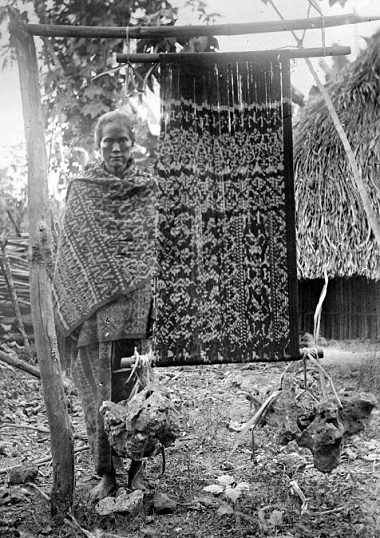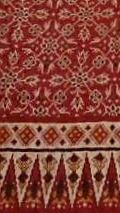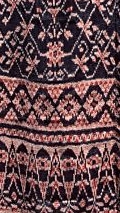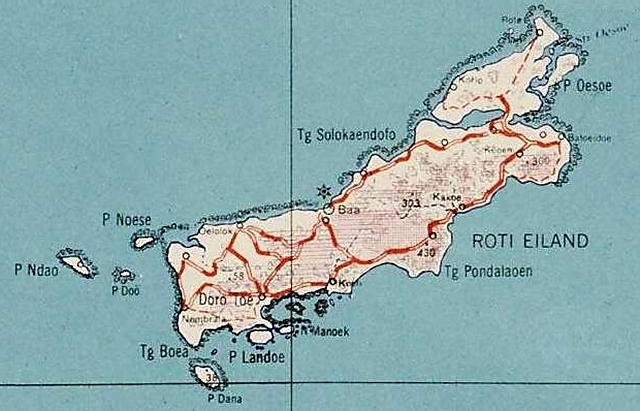Small Roti - great in intellectual contributionRoti, the southernmost island in the Indonesian archipelago, is generally described as a beautiful island, mostly level, but enriched with wooded hills, valleys, steep escarpments, mangrove coasts and sandy beaches. It is about 80 km long and 23 km wide lies about 16 km to the south-west of Timor. (Map showing location.) The capital, Ba'a, is on the western side of the island. As on Savu, life here depends on intensive use of the lontar palm, which provides the islanders with a wide range of resources, from nutrients to building material. The population is mainly occupied with fishing, some agriculture and trade, and the weaving of ikat, with tourism, mostly geared to surfing and diving, providing a slowly growing source of additional income.This remote and tiny island has one of the richest and most complex traditions of ikat textile design in Indonesia. Given the immediate visual appeal of Roti's ikat textiles, its accessibility (a short boat trip from Timor), and the relatively high educational level of its people, one would expect to find a wealth of information on these cloths and their production, or at least one exhaustive study, such as Geneviève Duggan made on neighbouring Savu. In fact, finding information on Roti ikat requires fairly dedicated searching; what little literature there is tends to be either out of print, buried deep in a distant library, or accessible only with a JSTOR password. Christianity without cultural eradicationFrom the middle of the 17th C. onwards, small Roti became a crucial foothold for the Dutch in the Timor area, which the Dutch East Indies Company was struggling, in the end successfully, to wrest away from Portuguese domination. Roti, with its numerous natural harbours, reliable source of sweet water, food and manpower, offered the Dutch a fallback position when their Concordia fort near Kupang was attacked. The Rotinese had little choice but to cooperate with the Dutch, who, after some initial resistance, proved too strong to resist. Through a series of formal trade treaties, the Dutch managed to co-opt a number of local rulers - the principal of which was the Raja of northern Termanu - who in their turn appointed officials to distribute power down the island's social strata.
Perhaps because christianisation on Roti took place so early, and without the iron fist of the Dutch missionary system, many of the local traditions were preserved. (Unlike on islands such as Alor and Adonara, where nearly all local traditions were stamped out with fanatical dedication.) The ruler of Thie was baptized in 1728 and in 1735 he established the first school in his area, provoking a rivalry among other rulers on the island to emulate his challenging initiative. By 1756 there were a dozen schools on the island - at a time when on most islands of the archipelago formal schooling was an unheard of concept. Escape from enslavementThis focus on education has remained a hallmark of Roti throughout the centuries, and helped them to escape the general enslavement of colonial times and become an elite element in the archipelago. When the Dutch, in 1681, after a bloody campaign in 1681 finally managed to wrest control over the island from the eighteen local rulers, they initially deported many Rotinese to Kupang, the capital of Timor, to work as slaves. But they soon discovered the intellectual and administrative abilities of the Rotinese, and began placing them in positions of responsibility, not just on Timor, but also in other parts of the Dutch East Indies, de facto starting a diaspora of the Rotinese that continues to the present day.As James J. Fox remarks in one of the lemmas he contributed to Southeast Asia: A Historical Encyclopedia, from Angkor Wat to East Timor, "Because of the advantages of their educational system, Rotinese have figured significantly in Indonesian national life." It is tempting to link the obvious intelligence of the Rotinese to the style of their wonderful ikat textiles, which tend to be devoid of figurative elements, and have an almost mathematical level of intricacy. The ikat textiles of Roti - patola inspired status symbolsThe ornamentation of Rotinese ikat textiles is formally prescribed, and identifies its wearers by class, status and origin, giving the pieces almost heraldic status. Curiously though, each and every Roti ikat has its own individuality: no two are the same. So, while the established formulae for the social identification of the wearer are firm, the weavers have great creative latitude in design execution, similar to the Indian raga system, which lays down the traditional musical foundations in a very strict manner,
Most Rotinese textiles, all with few exceptions decorated by means of the ikat resist technique, clearly show the impact that the patola trade cloths from Gujarat had on style concepts on the island. This impact was due to the fact that the Dutch colonisers handed patola only to a chosen few (only five per mil of any shipment of cloths might be patola), on the islands where they were most active creating elites that were distinguishable by their possession of these remarkable double ikat cloths, so devilishly hard to make that the locals tended to ascribe them magical, spiritual, or in any case supernatural powers. One of the most common motifs is the eight-rayed flower or jilamprang, on Roti called the 'black motif. And nearly all Rotinese ikat lafa and dula (man's cloths) have the typical tumpal borders consisting of a row of triangles alternated with inverted triangles. There are few other islands where the imitation of patolu patterning is so marked. Only in the Palembang district of Sumatra, on Bali and in the Lio district of Flores do we see similar close adherence to the original pattern. Click here for a few comparisons of a patolu with a cloths from Roti: | ||||||||||||||||||||||





